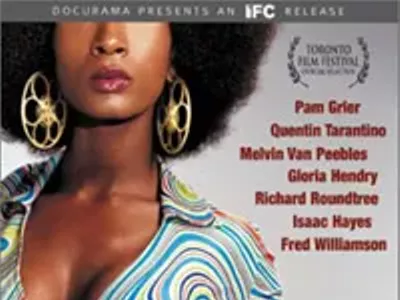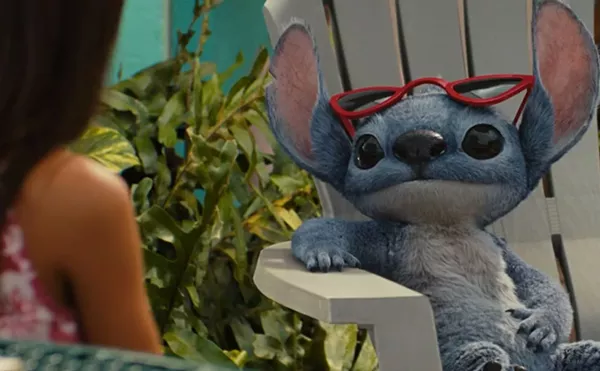
Audio By Carbonatix
[
{
"name": "GPT - Leaderboard - Inline - Content",
"component": "35519556",
"insertPoint": "5th",
"startingPoint": "3",
"requiredCountToDisplay": "3",
"maxInsertions": 100,
"adList": [
{
"adPreset": "LeaderboardInline"
}
]
}
]
She flows and crashes, like water. Her hips whip like waves in the wind. Her legs, dark chocolate and smooth as silk, kick and crash in a stern, matriarchal stomp. And she manipulates the flow of sound — the drumming of Medune, Ebou and Bi — with each commanding movement.
Mame Marie’s (Americans pronounce her name “Mama Marie”) body talks so fluently that she instructs her students with hardly a word spoken. No one can hear above the beating drums, especially not inside this church gymnasium, so the pupils in this African dance class watch and receive instruction from Mame Marie’s legs. Arms. Shoulders. Dreadlocks. Hips. Eyes.
Perform the movement twice. Face the students. Give them the floor. This communication, indicative of West Africans’ ability to communicate with one another through drum and dance for centuries, lasts an hour.
“Drumming and dancing is not just drumming and dancing,” says Jeana Gaskill Tall, executive director of the Global African-American Network (GAAN) and president of the Student African-American Network (SAAN) at the University of Detroit Mercy.
“In American culture, it’s an avenue to have a good time. But in other cultures, dancing and drumming actually mean something. You’re communicating. Let’s take a look at that and expand on that in an academic setting.”
Tall founded GAAN in 1998 to bridge the gap between West Africans and African-Americans. Through the organization, West African culture is promoted to African-Americans, while African-Americans are encouraged to engage in trade with West African nations. SAAN was formed in the fall of 2002 to give GAAN access to students and campus life. SAAN then launched the West African Cultural Exchange Program, which brought in Mame Maria, Medoun, Ebou and Bi almost two years ago to teach the dance class.
“We have about 400 years of post-slavery culture,” Tall says of African-Americans. “Without being exposed to what happened before that, most of what we attribute to what we call the black culture is pretty much plastic and made-up.”
Tall’s attempts at securing funding for GAAN/SAAN proved futile during the organization’s early years. But a meeting with Lara Wasner, director of Language and Cultural Training at UDM, opened a door of opportunity for both the university and the fledgling nonprofit.
“My department has been successful in providing language training around the Detroit metropolitan area,” says Wasner. “But what we’re trying to do is expand our cultural programs, and include programs that resonate with the community, and allow all people to experience other cultures. I thought this was a really great program. Dance has personally been an expression of creativity for me for a long time. And it allows UDM and the community to come together.”
A class based on the GAAN/SAAN mission is set to start on Feb. 3. A second session will begin on March 17. Both classes will heavily incorporate drum and dance on the front end, and address trade and social issues on the back end. This mutually beneficial relationship gives GAAN/SAAN a chance to expand their programming, and to pull UDM closer to its surrounding community.
Tall has also secured a performance grant from the Detroit Institute of Arts. The dance Mame Marie teaches tonight, “Sabar,” is in preparation for a Feb. 16 DIA performance. The performing troupe includes students from Oak Park’s Nsoroma Institute and members of the Grandale Presbyterian Church’s African-American Arts and Culture Society.
The most noticeable difference between African and African-American dance forms is the marketing. Both are sexual and energetic, but African dance is more sensual, while African-American dance forms arguably lean more toward eroticism.
“Energy and love, and power,” says Mame Marie. “That’s West African dance. Back home, men can have four wives. And if you don’t know how to dance that well or know how to move, you don’t get the best husband.”
Mame Marie, who is Senegalese, also adds that the dance and drum carry other meanings. For West African boys, growing up drumming is as common as American youth growing up on McDonald’s. Yet the standards are different. There are rituals for boyhood, as well as the transition into manhood. Circumcision takes place at a different age in some West African countries. And as Mame Marie indicates, marriage is approached with a different philosophy.
GAAN/SAAN and UDM hope to affect our perception of West African society. Tall suggests that West Africa’s link to African-Americans is key to understanding pre- and post-slavery era African heritages.
Imagine the possibilities if the movement of hips and the beating of drums can improve communication between people, between nations. Has the president tried that option yet?
“Sabar” (a pilot program of six classes on dance, drum and storytelling open to the public) begins Monday, Feb. 3, as part of the West African Cultural exchange Program at the University of Detroit Mercy. A second session begins March 17. For information on registration fees and locations, call Lara Wasner at 313-993-6191.




